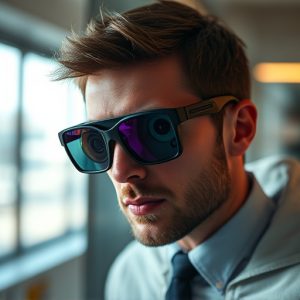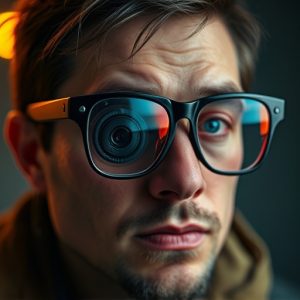Spy Glasses with Hidden Cameras: A Guide to Features, Usage, and Legal Boundaries
Spy glasses equipped with hidden cameras have advanced into sophisticated tools for discreet survei…….
Spy glasses equipped with hidden cameras have advanced into sophisticated tools for discreet surveillance, offering users high-definition recording capabilities in various settings. These glasses feature stealthy camera integration for covert recording, user-friendly interfaces, and secure SD card storage that supports extended recording sessions without compromising footage quality. They include night vision for low-light environments, motion detection, and live streaming options, making them versatile for personal security, professional surveillance, or capturing important life events undetected. With features like wide-angle lenses, resolution options from 720p to 1080p, and loop recording, these devices blend into everyday wear while providing high-quality video capture. However, it's essential to navigate the legal and ethical implications of using such technology responsibly, ensuring compliance with privacy laws and respecting individuals' expectations of privacy to avoid legal repercussions and maintain ethical standards in surveillance practices.
Exploring the multifaceted world of spy glasses equipped with hidden cameras, this article delves into their advanced features and versatile applications. From uncovering their technical specifications to understanding the legal frameworks governing their use, readers will gain a comprehensive overview of these discreet surveillance devices. The insights provided will shed light on the practicality of spy glasses with SD card storage, ensuring users are well-informed about the benefits and ethical responsibilities of employing such technology.
Unveiling the Capabilities of Spy Glasses with Hidden Cameras: A Comprehensive Guide
Spy glasses with hidden cameras have become increasingly sophisticated tools for surveillance and documentation, offering users a discreet means to capture footage in public and private settings alike. These devices seamlessly integrate camera technology within the framework of a conventional eyewear item, allowing for covert recording without drawing unwanted attention. The miniature cameras embedded in these glasses are often equipped with high-definition lenses that can record crystal-clear video or take sharp still images. They are designed with user-friendliness in mind, featuring intuitive operation and easy-to-use interfaces.
Equipped with secure SD card storage, users can record for extended periods without the need for external data sources, ensuring that critical footage is safely stored on the device itself. The integrated SD card allows for ample storage capacity, which means capturing hours of footage without compromise on quality. Additionally, many models come with night vision capabilities, enabling recording in low-light conditions where traditional cameras might fail. This feature expands the versatility of spy glasses with hidden cameras, making them ideal for a variety of applications, from personal safety to professional surveillance tasks. With advanced motion detection and real-time video streaming options available, these devices offer comprehensive solutions for those seeking to enhance their monitoring capabilities without sacrificing subtlety or convenience.
The Technical Specifications and Applications of Spy Glasses with Built-in Cameras and SD Card Storage
Spy glasses with hidden cameras represent a sophisticated blend of technology and wearable aesthetics, offering users the ability to discreetly record their surroundings. These devices are equipped with high-definition cameras that capture clear, detailed footage, ensuring that the moments you wish to preserve are not just memories but visual records with exceptional clarity. The integrated SD card storage is a standout feature, allowing for substantial amounts of video data to be stored directly within the frame of the glasses, eliminating the need for external recording devices. This design innovation not only enhances the user’s mobility but also maintains a low profile, making it an ideal tool for security surveillance, personal safety, or capturing life’s precious moments without drawing attention.
In terms of technical specifications, these spy glasses boast advanced imaging sensors that often range from 720p to 1080p resolution, ensuring high-quality video capture. The wide-angle lenses provide a broad field of view, capturing more of the scene without compromising on image quality. The SD card storage capacity varies, with options supporting up to 32GB or more, which means hours of footage can be securely stored within the glasses themselves. This capability is particularly useful for extended recording sessions or when significant space is needed to store video evidence. Additionally, these devices are often equipped with features like loop recording, motion detection, and low-light enhancement, making them versatile and adaptable to a range of environments and use cases. Whether for professional investigative work or personal documentation purposes, spy glasses with hidden cameras represent a cutting-edge solution in the realm of covert surveillance technology.
Legal Considerations and Ethical Implications When Using Spy Glasses with Hidden Cameras
When integrating spy glasses with hidden cameras into one’s daily life, users must navigate a complex array of legal considerations and ethical implications. Legally, it is imperative to be cognizant of privacy laws that govern recording in public versus private spaces. In many jurisdictions, capturing footage in areas where individuals have a reasonable expectation of privacy may be prohibited without consent. For instance, covertly filming in someone’s home or bathroom could lead to serious legal repercussions. Even in public areas, the use of spy glasses must align with local surveillance laws to avoid violations that could result in criminal charges or civil litigation.
Ethically, the deployment of spy glasses with hidden cameras raises questions about consent and the right to privacy. Users should consider the potential impact on individuals being filmed without their knowledge. The ethical use of such devices demands a commitment to transparency and respect for the privacy of others. It is essential to reflect on the intentions behind recording—whether it’s for safety, personal documentation, or surreptitious spying. Users should ensure that their actions with these devices do not infringe upon the rights of others and that they use this technology responsibly and within the bounds of what is morally acceptable in society.


